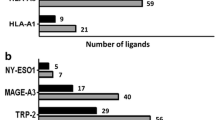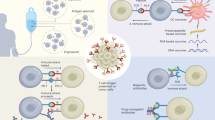Abstract
During the last few years, tumor immunology has gained impetus due to the molecular definition of T-ceil-recognized antigens and the mechanisms of suchrecognition, antigen processing, and presentation. To date, the majority of the identified melanoma antigens are shared among different melanomas and some are also expressed in tumors of different histology. However, unique antigens expressed solely by the melanoma autologous to the T-cell used for their characterization were also found. The identification of the immunogenic peptides, the minimal target entity required for T-cell recognition, has provided novel reagents for the development of peptide-based immunotherapy. These findings, together with the understanding of requirements for T-lymphocyte recognition and activation, allow the design of new therapeutic protocols. In addition, the large body of data now available on the fine mechanism of antigen processing and presentation have revealed not only the role of the MHC molecules but also that of other intracellular proteins, such as transporter associated with antigen processing-1 and -2 and proteosomerelated molecules. These findings suggest that, in order to select patients eligible for vaccination, the expression of the MHC allele involved in T-cell recognition, the profile of tumor antigens, and the status of the antigen-processing system should be carefully evaluated in tumors cells of prospective patients. In this review, some of the basic concepts of immune recognition and the current view of melanoma tumor antigens recognized by T-lymphocytes will be discussed along with the potential application of these findings in designing new therapeutic strategies.
Similar content being viewed by others
References
Real FX, Furukawa KS, Mattes MJ, Gusik SA, Cordon-Cardo C, Oettgen HF, Old LJ, Lloyd KO. Class I (unique) tumor antigens of human melanoma: identification of unique and common epitopes on a 90-kD glycoprotein. Proc Natl Acad Sci USA 1988; 85:3965.
Sahin U, Türeci ö, Schmitt H, Cochlavius B, Johannes T, Schmits R, Stenner F, Luo G, Schobert I, Pfreundschuh M. Human neoplasms elicit multiple specific immune responses in the autologous host. Proc Natl Acad Sci USA 1995; 92:11810.
Greenberg PD. Adoptive T-cell therapy of tumors: mechanisms operative in the recognition and elimination of tumor cells. Adv Immunol 1991; 49:281.
Parmiani G, Anichini A, Fossati G. Cellular immune response against autologous human malignant melanoma: are in vitro studies providing a framework for a more effective immunotherapy? J Natl Cancer Inst 1990; 82:361.
Ioannides CG, Freedman RS, Platsoucas CD, Rashed S, Kim YP. Cytotoxic T cell clones isolated from ovarian tumor-infiltrating lymphocytes recognized multiple antigenic epitopes on autologous tumor cells. J Immunol 1991; 146:1700.
Slingluff CL, Cox AL, Stover JM, Moore MM, Hunt DF. Engelard VH. The cytotoxic T-lymphocyte response to autologous squamous cell cancer of the lung: epitope reconstitution with peptides extracted from HLA-Aw68. Cancer Res 1994; 54:2731.
Schendel DJ, Gansbacher B, Oberneder R, Krigmair M, Hoffstetter A, Riethmuller G, Segurado OG. Tumor-specific lysis of human renal call carcinoma by tumor-infiltrating lymphocytes, I. HLA-restricted recognition of autologous and allogeneic tumor lines. J Immunol 1993; 151:4209.
Chen Q, Hersey P. MHC-restricted response of CD8+ and CD4+ T-cell clones from regional lymph nodes of melanoma patients. Int J Cancer 1992; 51:218.
Radrizzani M, Benedetti B, Castelli C, Longo A, Ferrara GB, Herlyn M, Parmiani G, Fossati G. Human allogeneic melanoma-reactive T-helper lymphocyte clones: functional analysis of lymphocyte-melanoma interactions. Int J Cancer 1991 ; 49:1.
Fopalian SL, Rivoltini I. Mancini M, Markus NR, Robbins PF, Kawakami Y, Rosenberg SA. Human CD4+ T cells specifically recognize a shared melanoma-associated antigen encoded by the tyrosinase gene. Proc Natl Acad Sci USA 1994; 91:9461.
Anichini A, Fossati G, Parmiani G. Heterogeneity of clones from a human metastatic melanoma detected by autologous cytotoxic T lymphocyte clones. J Exp Med 1986; 163:215.
Knuth A, Wölfel T, Kehmann E, Boon T, Meyer KH. Cytolytic T-cell clones against an autologous human melanoma: specificity study and definition of three antigens by immunoselection. Proc Natl Acad Sci USA 1989; 86:2804.
Anichini A, Mazzocchi A, Fossati G, Parmiani G. CTL clones from peripheral blood and from tumor site detect intratumor heterogeneity of melanoma cells: analysis of specificity and mechanism of action. J Immunol 1989; 142:3692.
Townsend ARM, Rothbard J, Gotch FM. The epitopes of influenza nucleoprotein recognized by cytotoxic T lymphocytes can be defined with short synthetic peptides. Cell 1986; 44: 959.
Germain RN. MHC-dependent antigen processing and peptide presentation: providing ligands for T lymphocyte activation. Cell 1994; 76:287.
Madden DR. The three-dimensional structure of peptide-MHC complexes. Annu Rev Immunol 1995; 13:587.
Taramelli D, Fossati G, Mazzocchi A, Delia D, Ferrone S, Parmiani G. Classes I and II HLA and melanoma-associated antigen expression and modulation on melanoma cells isolated from primary and metastatic lesions. Cancer Res 1986; 46:433.
Boon T, BruggenPvan der. Human tumor antigens recognized by T lymphocytes. J Exp Med 1996; 183:725.
Rivoltini L, Kawakami Y, Sakaguchi K, Southwood S, Sette A, Robbins PF, Marincola FM, Salgaller ML, Yannelli JR, Appella E, Rosenberg SA. Induction of tumor-reactive CTL from peripheral blood and tumor-infiltrating lymphocytes of melanoma patients by in vitro stimulation with an immunodominant peptide of the human melanoma antigen MART-1. J Immunol 1995; 154:2257.
Marchand M, Weynants P, Rankin E, Arienti F, Belli F, Parmiani G, Cascinelli N, Bourlond A, Vanwijck R, Humblet Y, Canon J-L, Laurent C, Naeyaert J-M, Plagne R, Deraemaeker R, Knuth A, JÄger E, Brasseur F, Herman J, Coulie PG, Boon T. Tumor regression responses in melanoma patients treated with a peptide encoded by gene MAGE-3 (letter). Int J Cancer 1995, 63:883.
JÄger E, Bernhard H, Romero P, Ringhoffer M, Arand M, Karbach J. Ilsemann C, Hagedorn M, Knuth A. Generation of cytotoxin T-cell responses with synthetic melanoma-associated peptides in vivo: implications for tumor vaccines with melanomaassociated antigens. Int J Cancer 1996; 66:162.
Topalian SL, Gonzales MI, Porkust M, Li YF, Southwood S, Sette A, Rosenberg SA, Robbins PF. Melanoma-specific CD4+ T cells recognize non mutated HLA-DR-restricted tyrosinase epitopes. J Exp Med 1996; 183:1965.
Mazzocchi A, Storkus W, Traversari C, Tarsini P, Mauerer MJ, Rivoltini L, Vegetti C, Belli F, Anichini A, Parmiani G, Castelli C. Multiple melanoma-associated epitopes recognized by HLA-A3-restricted CTLs and shared by melanoma but not melanocytes. J Immunol 1996; 167:3030.
Bakker AB, Marland G, Boer AJ de, Huijbens RJ, Danen EH. Adema GJ, Fidgor G. Generation of anti-melanoma cytotoxic T lymphocytes from healthy donors after presentation of melanoma-associated antigen-derived epitopes by dendritic cells in vitro. Cancer Res 1995; 55:5330.
Elsas A van, Burg SH van der, Minne CE van der, Borghi M, Mourer JS, Melief CJM, Schrier PI. Peptide-pulsed dendritic cells induce tumoricidal cytotoxic T lymphocytes from healthy donors against stably HLA-A*0201-binding peptides from Melan A/MART-1 self antigen. Eur J Immunol 1996; 26:1683.
Spagnoli GC, Schaefer C, Willimann TE, Kocher T, Amoroso A, Juretic A, Zuber M, Luscher U, Harder F, Heberer M. Peptide-specific CTL in tumor-infiltrating lymphocytes from metastatic melanomas expressing MART-1/Melan A, gp100 and tyrosinase genes; a study in an unselected group of HLA-A2.1-positive patients. Int J Cancer 1995; 64:309.
Loftus DJ, Castelli C, Clay TM, Squarcina P, Marincola FM. Nishimura MI, Parmiani G, Appella E, Rivoltini L. Identification of epitope mimics recognized by CTL reactive to the melanoma/melanocyte-derived peptide MART-127-35. J Exp Med 1996; 184:647.
Salgailer ML, Weber JS, Koening S, Yannelli JR, Rosenberg SA. Generation of specific anti-melanoma reactivity by stimulating human tumor-infiltrating lymphocytes with MAGE-1 synthetic peptide. Cancer Immunol Immunother 1994; 39:105.
Hu X, Chakraborty NG, Sporn JR, Kurtzman SH, Ergin MT, Mukherji B. Enhancement of cytolytic T lymphocyte precursor frequency in melanoma patients following immunization with the MAGE-1 peptide loaded antigen presenting cell-based vaccine. Cancer Res 1996; 56: 2479.
Rivoltini L, Loftus DJ, Barracchini K, Arienti F, Mazzocchi A, Biddison WE, Salgaller ML, Appella E, Parmiani G, Marincola FM. Binding and presentation of peptides derived from melanoma antigens MART-1 and gp100 by HLA-A2 subtypes: implications for peptide-based immunotherapy. J Immunol 1996; 156:3882.
Marincola FM, Hijzi Y, Fetch P, Salgaller ML, Rivoltini L, Cormier J, Kawakami Y, Rosenberg SA. Analysis of tissue expression of the melanoma associated antigens MART-1 and Gp-100 in metastastic melanoma. J Immunother. In press.
Kawakami Y, Eliyahu S, Jennings C, Sakaguchi K, Kang X, Southwood S, Robbins PF, Sette A, Appella E, Rosenberg SA. Recognition of multiple epitopes in the human melanoma antigen gp100 by tumor-infiltrating T lymphocytes associated with in vivo tumor regression. J Immunol 1995; 154:3961.
Cormier JN, Salgaller ML, Prevette T, Barracchini KC, Rivoltini L, Restifo NP, Rosenberg SA, Marincola FM. Enhancement of cellular immunity in melanoma patients immunized with a peptide from MART-1/Melan-A. Cancer J Sci Am. In press.
Grabbe S, Beissert S, Schwarz T, Granstein RD. Dendritic cells as initiators of tumor immune responses: a possible strategy for tumor immunotherapy? Immunol Today 1995; 16:117.
Celluzzi CM, Mayordomo WJ, Storkus WJ, Lotze MT, Falo LD Jr. Peptide-pulsed dendritic cells induce antigen-specific CTL-mediated protective tumor immunity. J Exp Med 1996; 183:283.
Paglia P, Chiodoni C, Rodolfo M, Colombo MR Murine dendritic cells loaded in vitro with soluble protein prime CTL against tumor antigen in vivo. J Exp Med 1996; 183 317.
Mayordomo JI, Zorina T, Storkus WJ, Zitvogel L, Celluzzi C. Falo LD Jr, Melief CJ, Ildstad ST, Kast WM, De Leo AB, Lotze MT. Bone marrow-derived dendritic cells pulsed with synthetic tumour peptides elicit protective and therapeutic antitumour immunity. Nature Med 1995; 1:1297.
Restifo NP. Recombinant anti-cancer vaccines. Cancer J Sci Am 1996; 2:16.
Warnier G, Duffour MT. Uyttenhove C, Perricaudet M. Haddada H, Boon T. Induction of a cytolytic T cell response in mice with a recombinant adenovirus coding for tumor antigen P815 A. Int J Cancer 1996; 67:303.
Zhai Y, Yang JC, Kawakami Y, Spiess P, Wadsworth SC, Cardoza LM, Couture LA, Smith AE, Rosenberg SA. Antigen-specific tumor vaccines. Development and characterization of recombinant adenovirus encoding MARTI or gp100 for cancer therapy. J Immunol 1996; 156:700.
Morton DL, Foshag LJ, Hoon DSB. Nizze JA. Wanek LA, Chang C, Davtyan DG, Gupta RK, Elashoff R, Irie RF. Prolongation of survival in metastatic melanoma after active specific immunotherapy with a new polyvalent melanoma vaccine. Ann Surg 1992; 216:463.
Parmiani G, Colombo MP. Somatic gene therapy of human melanoma: pre-clinical studies and early clinical trials. Melanoma Res 1995; 5:295.
Rosenberg SA, Yannelli JR, Yang JC, Topalian SL, Schwartzentruber DJ, Weber JS, Parkinson DR, Scipp CA, Einhorn JH, White DE. Treatment of patients with metastatic melanoma with autologous tumor infiltrating lymphocytes plus interleukin 2. J Natl Cancer Inst 1995; 86:1159.
Walter EA, Greenberg PD, Gilbert MJ, Finch RJ, Watanabe KS, Thomas ED, Riddell SR. Reconstitution of cellular immunity against cytomegalovirus in recipients of allogeneic bone marrow by transfer of T-cell clones from the donor. N Ensl J Med 1995; 333:1038.
Zier K, Gansbacher B, Salvadori S. Preventing abnormalities in signal transduction of T cells in cancer: the promise of cytokine gene therapy. Immunol Today 1996; 17:39.
Ferrone S, Marincola FM. Loss of HLA class I antigens by melanoma cells: molecular mechanisms, functional significance and clinical relevance. Immunol Today 1996; 16:487.
Author information
Authors and Affiliations
Rights and permissions
About this article
Cite this article
Castelli, C., Rivoltini, L., Mazzocchi, A. et al. T-cell recognition of melanoma antigens and its therapeutic applications. Int J Clin Lab Res 27, 103–110 (1997). https://doi.org/10.1007/BF02912443
Accepted:
Issue Date:
DOI: https://doi.org/10.1007/BF02912443




